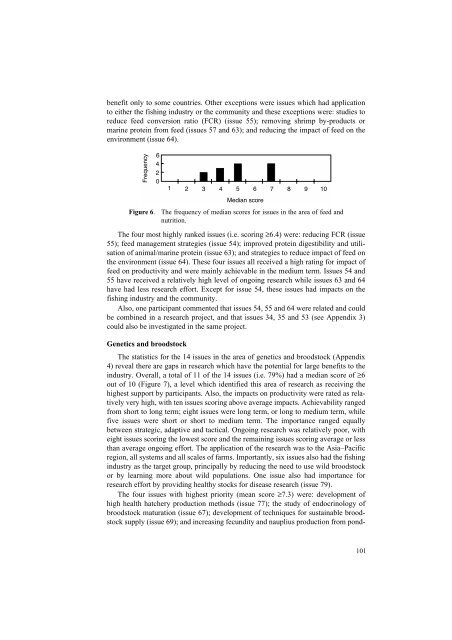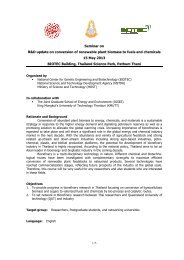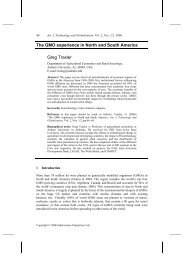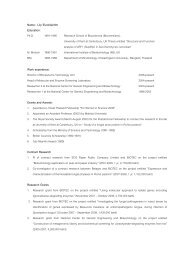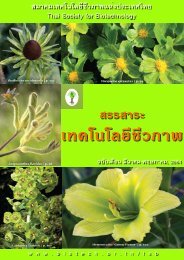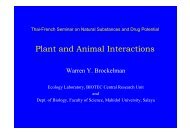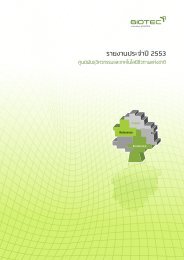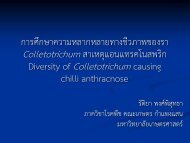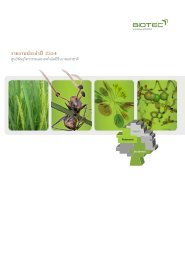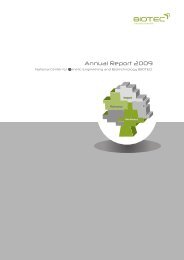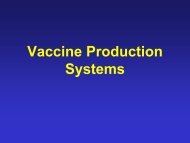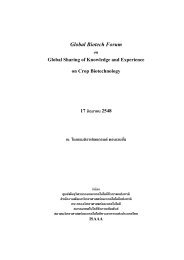Coastal Shrimp Aquaculture in Thailand: Key Issues for Research
Coastal Shrimp Aquaculture in Thailand: Key Issues for Research
Coastal Shrimp Aquaculture in Thailand: Key Issues for Research
You also want an ePaper? Increase the reach of your titles
YUMPU automatically turns print PDFs into web optimized ePapers that Google loves.
!! !benefit only to some countries. Other exceptions were issues which had applicationto either the fish<strong>in</strong>g <strong>in</strong>dustry or the community and these exceptions were: studies toreduce feed conversion ratio (FCR) (issue 55); remov<strong>in</strong>g shrimp by-products ormar<strong>in</strong>e prote<strong>in</strong> from feed (issues 57 and 63); and reduc<strong>in</strong>g the impact of feed on theenvironment (issue 64).A)7X#7',1Figure 6.TSQEThe four most highly ranked issues (i.e. scor<strong>in</strong>g "6.4) were: reduc<strong>in</strong>g FCR (issue55); feed management strategies (issue 54); improved prote<strong>in</strong> digestibility and utilisationof animal/mar<strong>in</strong>e prote<strong>in</strong> (issue 63); and strategies to reduce impact of feed onthe environment (issue 64). These four issues all received a high rat<strong>in</strong>g <strong>for</strong> impact offeed on productivity and were ma<strong>in</strong>ly achievable <strong>in</strong> the medium term. <strong>Issues</strong> 54 and55 have received a relatively high level of ongo<strong>in</strong>g research while issues 63 and 64have had less research ef<strong>for</strong>t. Except <strong>for</strong> issue 54, these issues had impacts on thefish<strong>in</strong>g <strong>in</strong>dustry and the community.Also, one participant commented that issues 54, 55 and 64 were related and couldbe comb<strong>in</strong>ed <strong>in</strong> a research project, and that issues 34, 35 and 53 (see Appendix 3)could also be <strong>in</strong>vestigated <strong>in</strong> the same project.Genetics and broodstockG Q R S F T U V W GEJ7?*&'!:,0)7The frequency of median scores <strong>for</strong> issues <strong>in</strong> the area of feed andnutrition.The statistics <strong>for</strong> the 14 issues <strong>in</strong> the area of genetics and broodstock (Appendix4) reveal there are gaps <strong>in</strong> research which have the potential <strong>for</strong> large benefits to the<strong>in</strong>dustry. Overall, a total of 11 of the 14 issues (i.e. 79%) had a median score of "6out of 10 (Figure 7), a level which identified this area of research as receiv<strong>in</strong>g thehighest support by participants. Also, the impacts on productivity were rated as relativelyvery high, with ten issues scor<strong>in</strong>g above average impacts. Achievability rangedfrom short to long term; eight issues were long term, or long to medium term, whilefive issues were short or short to medium term. The importance ranged equallybetween strategic, adaptive and tactical. Ongo<strong>in</strong>g research was relatively poor, witheight issues scor<strong>in</strong>g the lowest score and the rema<strong>in</strong><strong>in</strong>g issues scor<strong>in</strong>g average or lessthan average ongo<strong>in</strong>g ef<strong>for</strong>t. The application of the research was to the Asia–Pacificregion, all systems and all scales of farms. Importantly, six issues also had the fish<strong>in</strong>g<strong>in</strong>dustry as the target group, pr<strong>in</strong>cipally by reduc<strong>in</strong>g the need to use wild broodstockor by learn<strong>in</strong>g more about wild populations. One issue also had importance <strong>for</strong>research ef<strong>for</strong>t by provid<strong>in</strong>g healthy stocks <strong>for</strong> disease research (issue 79).The four issues with highest priority (mean score "7.3) were: development ofhigh health hatchery production methods (issue 77); the study of endocr<strong>in</strong>ology ofbroodstock maturation (issue 67); development of techniques <strong>for</strong> susta<strong>in</strong>able broodstocksupply (issue 69); and <strong>in</strong>creas<strong>in</strong>g fecundity and nauplius production from pond-101


